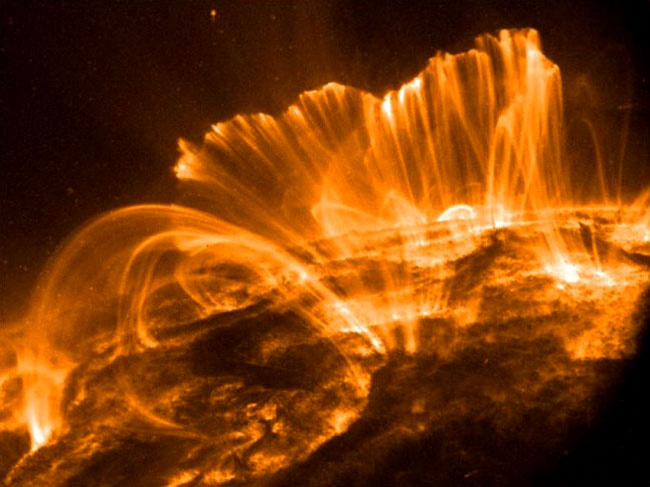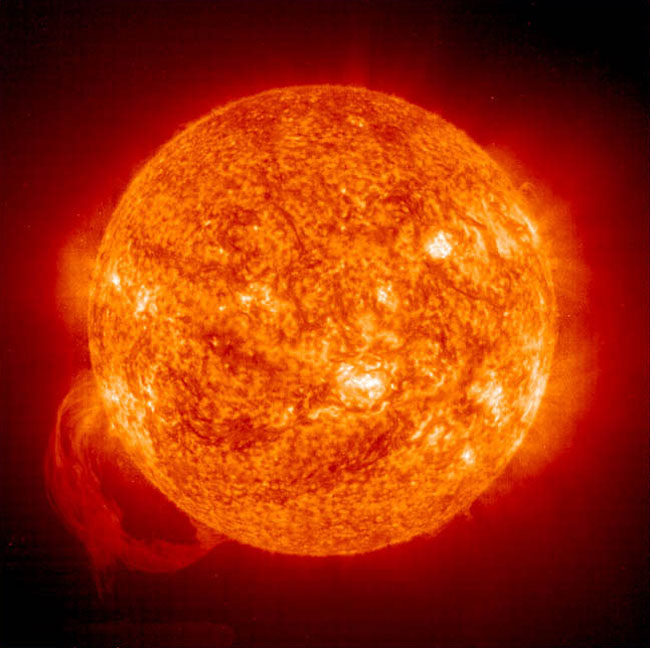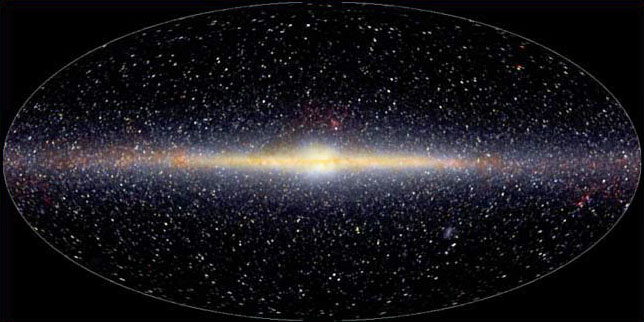|
Projecting
Nuclear Fusion onto the Sun
Jan 06, 2006
from
Thuntherbolts Website
What is the source of the Sun’s light and heat? Throughout history
people have proposed answers to this question that have always
reflected human experience. The Sun was a shining god or a “spark”
cast off in the creation.
Later it was a pile of
burning sticks or coal.

By the nineteenth
century, astronomers had become accustomed to thinking that gravity
was the dominant force in the heavens. So they began to conjecture
that the energy of the Sun might be due to “gravitational collapse”,
a compression of solar gases by gravity. This simple hypothesis, its
proponents claimed, could provide the required energy output for a
few tens of millions of years.
By the late 19th century, however, geologists were confident that
Earth was much older than the astronomers’ model would allow, and
the conflict between astronomy and geology continued for several
decades. Then, in 1920, the British astronomer Sir Arthur Eddington
combined the principle of gravitational collapse with an exciting
new principle in the physical sciences—nuclear fusion. He proposed
that at the core of the Sun, pressures and temperatures induced a
nuclear reaction fusing hydrogen into helium.
In 1939 two astrophysicists, Subrahmanyan Chandrasekhar and
Hans Bethe, working independently, began to quantify the
gravitational collapse and nuclear fusion hypothesis. Bethe
described the results of his calculations in a brief paper entitled
"Energy Production in Stars”, published in 1939.
The model that followed the work of Eddington, Chandrasekhar, and
Bethe described a “nuclear furnace” responsible for igniting stars.
And for decades now cosmologists, astronomers, and astrophysicists
have accepted the basic concept as fact.
In the early formulations of the “standard model” of star formation,
it was said that the gravitational force within a primordial cloud
leads to its progressive compression into a “circumstellar disk”, as
the outer material in the cloud “falls” inward, and gravity gives
birth to a star-sized sphere, whose core temperature continues to
rise under increasing pressures.
Collisions of atoms
within the core eventually become so energetic that electrons are
stripped from their nuclei, leaving free electrons and hydrogen
protons (a plasma as we now understand it). In stars roughly
comparable to our Sun, with envisioned core temperatures less than
15 million Kelvin, the nuclear reaction begins when hydrogen protons
are joined or stuck together in the “proton-proton fusion” of
hydrogen into helium.
Critics, however, pointed out that the temperatures given by
standard gas laws are not sufficient to provoke nuclear fusion. They
cited the “Coulomb barrier”, in this case the electric repulsion
between two protons, or like charges. Once protons are fused, they
could be held together by the strong nuclear force, but that force
dominates only at short distances.
To achieve fusion, it
would be necessary for protons to cross the barrier of the repulsive
electric force, which is sufficient to keep the protons apart
forever. But Eddington’s successors accomplished the impossible by
something called quantum tunneling, enabling an extremely small
percentage of protons to simply “appear” inside the barrier at any
particular time.
It is ironic that the early objections to the fusion model of the
Sun focused on the powerful electric force. This was long before
arrival of the space age with its discovery that the charged
particles of plasma permeate interplanetary and interstellar space,
and long before any systematic investigations of plasma and
electricity in space.
Advocates of the “nuclear furnace” made a series of fundamental
assumptions common to astronomy long before the emergence of a
nuclear model of the Sun. The credibility of these assumptions was
not an issue to them. They assumed that diffuse clouds of gas in
space would collapse gravitationally into star-sized bodies. They
assumed that the Sun’s mass could be calculated simply from the
orbital motions of the planets. They assumed that Newtonian
calculations of mass, coupled with standard gas laws, enabled them
to determine the pressure and temperature of the Sun’s core.
The pioneers of the nuclear furnace also followed another assumption
common to astronomy in their time—that the Sun and planets are
electrically neutral. They gave no consideration to the role of
electricity and no consideration to the role of the magnetic fields
that electric currents generate.
Are the assumptions made in the first half of the twentieth century
still warranted after decades of space exploration? Those proposing
an electrical perspective, based on more recent data, insist that
the earlier conjectures are not only unwarranted, but discredited by
direct observation and measurement. They emphasize that every
feature of the Sun as we now observe it, defies both the
gravitational assumptions and the standard gas laws relating to
pressure, density, temperature and relative motions of gases.
The deepest observable
surface of the Sun yields a temperature of about 6,000 degrees
Kelvin. As we peer into the darker interior of sunspots we see
cooler regions, not hotter. But moving outward to the bottom of the
corona, the temperature jumps spectacularly to almost 2 million
degrees. Thus, the superheated shell of the Sun’s corona reverses
the expected temperature gradient predicted by models of internal
heating.
It seems that the Sun does not even “respect” gravity. The mass of
charged particles expelled by the Sun as the solar wind continues to
accelerate beyond Mercury, Venus, and Earth. Solar prominences and
coronal mass ejections do not obey gravity either. Nor does sunspot
migration. Nor does the movement of the atmosphere, since the upper
layers rotate faster than the lower, reversing the situation
predicted by theory, while the equatorial atmosphere completes its
rotation more rapidly than the atmosphere at higher latitudes,
another reversal of predicted motions.
If the Sun’s atmosphere
were subject only to gravity and the hot surface, it should be only
a few thousand kilometers thick instead of the hundred thousand
kilometers or more that we measure. Even the shape of the Sun defies
the expectations of theory. The revolving Sun should be an oblate
sphere. But it is a virtually perfect sphere, as if gravity and
inertia have been overruled by something else.
For the electrical theorists, the “something else” should be obvious
from the dominant observed features of the Sun (in contrast to
things assumed but never seen).
The anomalies facing the standard
model of the Sun are predictable features of a glow discharge, as we
shall demonstrate in coming Pictures of the Day.
Back to
Contents
The Electric
Glow of the Sun
Apr 27, 2005
from
Thuntherbolts Website
A little known fact: Popular ideas about the Sun have not fared well
under the tests of a scientific theory. The formulators of the
standard Sun model worked with gravity, gas laws, and nuclear
fusion. But closer observation of the Sun has shown that electrical
and magnetic properties dominate solar behavior.
For centuries, the nature of the Sun’s radiance remained a mystery
to astronomers. The Sun is the only object in the solar system that
produces its own visible light. All others reflect the light of the
Sun. What unique trait of the Sun enables it to shine upon the other
objects in the solar system?
Today, astronomers assure us that the most fundamental question is
answered. The Sun is a thermonuclear furnace. The ball of gas is so
large that astronomers envision pressures and densities within its
core sufficient to generate temperatures of about 16 million
K—producing a continuous “controlled” nuclear reaction.

Most astronomers and
astrophysicists investigating the Sun are so convinced of the fusion
model that only the rarest among them will countenance challenges to
the underlying idea. Standard textbooks and institutional research,
complemented by a chorus of scientific and popular media, “ratify”
the fusion model of the Sun year after year by ignoring evidence to
the contrary.
A growing group of independent researchers, however, insists that
the popular idea is incorrect. These researchers say that the Sun is
electric. It is a glow discharge fed by galactic currents. And they
emphasize that the fusion model anticipated none of the milestone
discoveries about the Sun, while the electric model predicts and
explains the very observations that posed the greatest quandaries
for solar investigation.
More than 60 years ago, Dr. Charles E. R. Bruce, of the Electrical
Research Association in England, offered a new perspective on the
Sun. An electrical researcher, astronomer, and expert on the effects
of lightning, Bruce proposed in 1944 that the Sun’s,
"photosphere has the
appearance, the temperature and the spectrum of an electric arc;
it has arc characteristics because it is an electric arc, or a
large number of arcs in parallel."
This discharge
characteristic, he claimed, "accounts for the observed granulation
of the solar surface." Bruce’s model, however, was based on a
conventional understanding of atmospheric lightning, allowing him to
envision the “electric” Sun without reference to external electric
fields.
Years later, a brilliant engineer, Ralph Juergens, inspired by
Bruce’s work, added a revolutionary possibility. In a series of
articles beginning in 1972, Juergens suggested that the Sun is not
an electrically isolated body in space, but the most positively
charged object in the solar system, the center of a radial electric
field. This field, he said, lies within a larger galactic field.
With this hypothesis, Juergens became the first to make the
theoretical leap to an external power source of the Sun.
Juergens proposed that the Sun is the focus of a "coronal glow
discharge" fed by galactic currents. To avoid misunderstanding of
this concept, it is essential that we distinguish the complex,
electrodynamic glow discharge model of the Sun from a simple
electrostatic model that can be easily dismissed. Throughout most of
the volume of a glow discharge the plasma is nearly neutral, with
almost equal numbers of protons and electrons.
In this view, the charge
differential at the Earth’s distance from the Sun is smaller than
our present ability to measure—perhaps one or two electrons per
cubic meter. But the charge density is far higher closer to the Sun,
and at the solar corona and surface the electric field is of
sufficient strength to generate all of the energetic phenomena we
observe.
Today, the electrical theorists Wallace Thornhill and
Donald Scott urge a critical comparison of the fusion model and
the electrical model.
Given what we now know about the Sun,
-
Which
model meets the tests of unity, coherence, simplicity, and
predictability?
-
Why did so many discoveries surprise investigators
and even contradict the expectations of the fusion model?
-
Is there
any fundamental feature of the Sun that contradicts the glow
discharge hypothesis?
Our closer looks at the Sun have revealed the pervasive influence of
magnetic fields, which are the effect of electric currents.
Sunspots, prominences, coronal mass ejections, and a host of other
features require ever more complicated guesswork on behalf of the
fusion model. But this is the way an anode in a coronal glow
discharge behaves!
In the electrical model, the Sun is the “anode” or positively
charged body in the electrical exchange, while the "cathode" or
negatively charged contributor is not a discrete object, but the
invisible “virtual cathode” at the limit of the Sun’s coronal
discharge. (Coronal discharges can sometimes be seen as a glow
surrounding high-voltage transmission wires, where the wire
discharges into the surrounding air). This virtual cathode lies far
beyond the planets. In the lexicon of astronomy, this is the “heliopause.”
In electrical terms, it is the cellular sheath or “double layer”
separating the plasma cell that surrounds the Sun ("heliosphere”)
from the enveloping galactic plasma.
In an electric universe, such cellular forms are expected between
regions of dissimilar plasma properties. According to the glow
discharge model of the Sun, almost the entire voltage difference
between the Sun and its galactic environment occurs across the thin
boundary sheath of the heliopause. Inside the heliopause there is a
weak but constant radial electrical field centered on the Sun. A
weak electric field, immeasurable locally with today's instruments
but cumulative across the vast volume of space within the
heliosphere, is sufficient to power the solar discharge.
The visible component of a coronal glow discharge occurs above the
anode, often in layers. The Sun’s red chromosphere is part of this
discharge. (Unconsciously, it seems, the correct electrical
engineering term was applied to the Sun’s corona.) Correspondingly,
the highest particle energies are not at the photosphere but above
it. The electrical theorists see the Sun as a perfect example of
this characteristic of glow discharges—a radical contrast to the
expected dissipation of energy from the core outward in the fusion
model of the Sun.
At about 500 kilometers (310 miles) above the photosphere or visible
surface, we find the coldest measurable temperature, about 4400
degrees K. Moving upward, the temperature then rises steadily to
about 20,000 degrees K at the top of the chromosphere, some 2200
kilometers (1200 miles) above the Sun's surface. Here it abruptly
jumps hundreds of thousands of degrees, then continues slowly
rising, eventually reaching 2 million degrees in the corona. Even at
a distance of one or two solar diameters, ionized oxygen atoms reach
200 million degrees!
In other words the “reverse temperature gradient,” while meeting the
tests of the glow discharge model, contradicts every original
expectation of the fusion model.
But this is only the first of many enigmas and contradictions facing
the fusion hypothesis. As astronomer Fred Hoyle pointed out years
ago, with the strong gravity and the mere 5,800-degree temperature
at the surface, the Sun’s atmosphere should be only a few thousand
kilometers thick, according to the “gas laws” astrophysicists
typically apply to such bodies. Instead, the atmosphere balloons out
to 100,000 kilometers, where it heats up to a million degrees or
more. From there, particles accelerate out among the planets in
defiance of gravity. Thus the planets, Earth included, could be said
to orbit inside the Sun's diffuse atmosphere.
The discovery that blasts of particles escape the Sun at an
estimated 400- to 700-kilometers per second came as an uncomfortable
surprise for advocates of the nuclear powered model. Certainly, the
“pressure” of sunlight cannot explain the acceleration of the solar
“wind”. In an electrically neutral, gravity-driven universe,
particles were not hot enough to escape such massive bodies, which
(in the theory) are attractors only. And yet, the particles of the
solar wind continue to accelerate past Venus, Earth, and Mars. Since
these particles are not miniature “rocket ships,” this acceleration
is the last thing one should expect!
According to the electric theorists, a weak electric field, focused
on the Sun, better explains the acceleration of the charged
particles of the solar wind. Electric fields accelerate charged
particles. And just as magnetic fields are undeniable witnesses to
the presence of electric currents, particle acceleration is a good
measure of the strength of an electric field.
A common mistake made by critics of the electric model is to assume
that the radial electric field of the Sun should be not only
measurable but also strong enough to accelerate electrons toward the
Sun at “relativistic” speeds (up to 300,000 kilometers per second).
By this argument, we should find electrons not only zipping past our
instruments but also creating dramatic displays in Earth’s night
sky.
But as noted above, in the plasma glow-discharge model the
interplanetary electric field will be extremely weak. No instrument
placed in space could measure the radial voltage differential across
a few tens of meters, any more than it could measure the solar wind
acceleration over a few tens of meters. But we can observe the solar
wind acceleration over tens of millions of kilometers, confirming
that the electric field of the Sun, though imperceptible in terms of
volts per meter, is sufficient to sustain a powerful drift current
across interplanetary space. Given the massive volume of this space,
the implied current is quite sufficient to power the Sun.
Look for more details on the drift current, solar magnetic fields,
nuclear reactions, and many other features of the Sun in upcoming
Pictures of the Day.
Back to
Contents
The Wayward
Sun
by Rens van der
Sluijs
Jan 07, 2005
from
Thuntherbolts Website

ABOVE: Our Milky Way
Galaxy as photographed in Infrared by NASA's COBE Spaceprobe.
The sun courses along
the zodiac and has no direct connection to the Milky Way. Yet
various cultures claim that the sun formerly moved on the Milky Way.
This theme is particularly prominent in tropical Africa. For
example, the west-equatorial Pygmies assert that the Milky Way is Kmvum's or
Mvum's road to the sun in order to renew himself.
They
call it dzi ko or nwa ko, "road" or "path of the sky".
The Rundi tighten the
connection of the Milky Way and the sun even further, calling the
Milky Way inzira y'izuba, "the sun's track". On condition that such
folkloristic "wisdom" is not always meaningless, a possible
explanation for such traditions could be that they preserve memories
of some other bright object moving over the Milky Way, an object
bright enough to qualify as a sun.
This solution is
recommended by the version of the Fiote of the Loango Coast, that
involves a large luminary other than the sun journeying over the
Milky Way:
"The Star Way [Galaxy] is the road for a funeral
procession of a huge star which, once, shone brighter from the sky
than the Sun."
That such curious traditions can hardly be dismissed as nonsensical
oddities follows from the existence of a precise parallel within the
confines of ancient Greece. Among the most obscure elements of the
teaching of the Pythagoreans, including Philoponus, Oenopides and
Metrodorus of Chios, was the belief that the sun was once on a
different course: the Milky Way.
This former sun was
identified as Phaethon. Phaethon, of course, was the tragic hero who
aspired to succeed his father Helius, the sun, but failed to manage
the solar chariot and fell from the sky amid a catastrophic fire
that set the world ablaze. Aristotle and a handful of later authors
identify Phaethon the mock sun as the luminary that moved on the
Milky Way.
Aristotle wrote:
"The so-called
Pythagoreans give two explanations. Some say that the Milky Way
is the path taken by one of the stars at the time of the
legendary fall of Phaethon: others say that it is the circle in
which the sun once moved. And the region is supposed to have
been scorched or affected in some other such way as a result of
the passage of these bodies."
The above is just one of
scores of anomalous yet universal themes that cry out for an
explanation. It is likely that the "sun" and the "Milky Way" were
metaphoric replacements of some other objects formerly observed in
the sky that are currently lost. For example, the former "sun" could
have been a giant comet, as the Jesuit scholar Kugler proposed long
ago, and the "Milky Way" that was produced in its trail could be
based on an increased zodiacal light, such as proposed by Clube et
al. Alternative explanations can be proposed.
The plasma model
advocated on this website includes the possibility that many myths
trace to an episode in which the magnetosphere of the earth was once
visibly glowing as a semi-permanent “aurora”.
If such conditions
really prevailed in the Holocenic past, it stands to reason that
myths of a former sun treading the Galaxy derived from genuine
memories of a turbulent sky.
Back to
Contents
The Pedestal
of the Sun
by Rens van der
Sluijs
Dec 14, 2004
from
Thuntherbolts Website
The image shown here is described as a "drum pilaster capped with a
wheel". It was produced in the 3rd century A. D. in the north-Indian
settlement of Amaravati. The so-called "wheel of the law" on the top
of the column was a popular Vedic expression of the supreme sun god.
Ananda Coomaraswamy,
one of the best authorities in the field of Buddhist iconography,
explained that this and similar images portrayed Buddha in his
aspect as a pillar of fire, surmounted by a central sun.
The relief is relatively
late and could easily be dismissed as an interesting curiosity, were
it not that some of the earliest civilizations spoke of the first
sun in similar terms.

Some passages of the old
Egyptian Pyramid Texts make it
clear that the sun god Ra‘ was located in the circumpolar region of
the sky. This is odd considering that the sun never ventures close
to the pole. Even stranger is the tendency to place this sun god on
the summit of an elongated object.
At Hermopolis, the sun
god was represented as standing on the primordial mound, which was
the Egyptian version of the cosmic mountain as the first object to
be created. At Heliopolis, the sun god was held to rise daily from
the fire that burned at dawn on the top of the holy sky-filling
Ashet - or Persea-tree. In this capacity, the sun god was better
known as the Benu or Bennu, the solar bird rendered
Phoenix in Greek.
And an informative, yet
cryptic paean to Ra‘ composed in Thebes attributes the cycle of day
and night to the sun god's entry and exit of his "circle". The
reference to the deity's outstretched wings shows that this circle
must be thought of as the ring one sees in the image of the winged
disc.
Moreover, this winged
disc is located on top of a pillar:
"Thou spreadest
out thy wings …
… thou performest thy acts of creation in thy Great Disk.
Praise be unto thee, O Ra, exalted Power, thou World-soul
who
resteth on his high place …
… Thou sendest light unto thy Circle, thou makest darkness
to be in thy
Circle …thou enterest thy Circle...
… Thou goest in and comest out, thou comest out and goest in
to thy
hidden Circle …
… lord of souls who art in the house of thine obelisk …
Sphinx-god,
Obelisk-god …"
There is no escaping the
fact that the composer of this hymn thought of Ra‘ as the winged red
disc placed motionless "on his high place", the obelisk. This means
that the subject of veneration here and in those passages in the
Pyramid Texts was another sun than the ordinary sun which
crosses the sky.
It appears that the
earliest form of the sun god worshipped by the Egyptians was a
radiant, stationary sphere placed atop a glowing column. Only in
subsequent times was this sun god assimilated to our revolving sun.
This analysis is supported by a multitude of similar accounts found
in early sources from around the world. In many cases the abode of
the motionless sun and his pedestal is identified as the cosmic
centre and the axis mundi. For example, one of the sacred
Indian writings asserts that the sun 'never leaves Meru' and an
epigraphical text describes Meru as the support of the sun.
Meru was the Vedic
equivalent of the cosmic mountain, which was explicitly located at
the polar centre of the earth. The upshot is that the archetype of
the stationary sun is best explained as a memory of a luminous
object that appeared for some time on the axis mundi. But this
requires that the ancients experienced a different, more turbulent
sky than the one presently seen.
The model advocated here involves the hypothesis that the cosmic
axis was once visible as a stupendous, heaven-reaching column in the
"centre" of the world. It was formed of glowing plasma that was
produced by high-energy disturbances in the geomagnetic field and an
increased influx of charged particles from the solar wind.
Plasma physicist
Anthony Peratt has produced a detailed analysis of the
evolutionary sequence of this plasma column. His research indicates
that the topmost toroids of the column at some point merge and
produce the image of a cusp or cup enclosing a central sphere.
This central sphere
bears all the hallmarks of the stationary sun born of the "lotus
flower" that the myths hint at.
Back to
Contents
|



